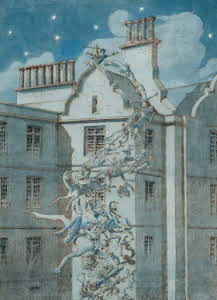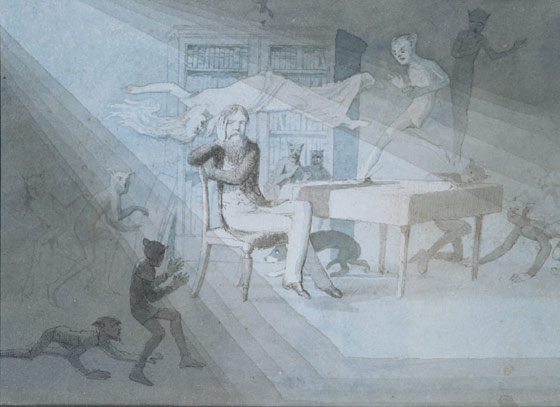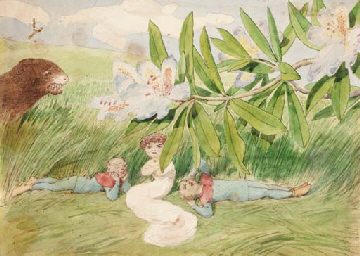Torment and talent of Charles Altamont Doyle
Charles Altamont Doyle was born on 25th March 1832. Today he is mainly remembered for being the father of Scottish writer Arthur Conan Doyle, the creator of Sherlock Holmes. However, Charles Altamont Doyle was a talented illustrator and watercolourist. He was the son of Irish artist John Doyle, the political cartoonist known by the pen name as H.B., and Marianna Conan Doyle. Charles Altamont Doyle moved to Edinburgh in 1849, where he worked as an assistant surveyor at the Scottish Office of Work. It was in Edinburgh that he married Mary Foley and they went on to have several children including Arthur Conan Doyle.
In addition to his full-time employment he produced illustrations for a number of books, including for the Our Trip to Blunderland (1877) by Lewis Carroll, as well as designs for a number of journals. He also exhibited at the Scottish Royal Academy. His paintings, were often of fantasy scenes, many featuring fairies. He suffered with severe bouts of depression and alcoholism. As his condition worsened his work became darker and more sinister. Concerns about his heavy drinking and impact on his mental health led to his dismisal from his job in 1876, although he did receive a pension. Five years later, after growing family worries about his moods and desperate attempts to obtain alcohol, he was admitted to the nursing home of Blairerno House at Drumlithie in the Mearns. At times he still managed to obtain alcohol and there were incidents of disturbing behaviour. Following an aggressive attempt to leave Blairerno House he was sent to Sunnyside, Montrose Royal Lunatic Asylum on 26 May 1885.
His bouts of depression worsened at Sunnyside and he began experiencing epileptic seizures. The effects of long term drinking had negative effects on his memory and mental health. It is described that he would tell staff that he was receiving messages from the unseen world and accused them of being devils. Nevertheless, he continued to paint and did experience calmer periods. In 1888 he completed illustrations for an edition of his son's first Sherlock Holmes novel A Study in Scarlet. His work over the period that he remained at the asylum often combined fantastical images of animals with other imaginary creatures. He maintained to his family that he was sane and had been wrongfully confined. In doing so he complied sketchbooks with caricatures, drawings of fairies and notes. He inscribed the frontispiece of his sketchbook diary: ‘Keep steadily in view that this Book is ascribed wholly to the produce of a MADMAN. Whereabouts would you say was the deficiency of Intellect? or depraved taste? If in the whole book you can find a single evidence of either, mark it and record it against me.’
In January 1891 he was transferred to Edinburgh Royal Infirmary and died in the Crichton Royal Institution in Dumfries on 10th October 1893. Arthur Conan Doyle remembered his father with fondness. In his autobiography he wrote ".. full of the tragedy of unfulfilled powers and of underdeveloped gifts. He had his weaknesses, as all of us have ours, but he had also some very remarkable and outstanding virtues. A tall man, long-bearded, and elegant, he had a charm of manner and a courtesy of bearing which I have seldom seen equalled. His wit was quick and playful. He possessed, also, a remarkable delicacy of mind which would give him moral courage enough to rise and leave any company which talked in a manner which was coarse…" Arthur Conan Doyle mounted an exhibition of his father's works in 1924 at the Brook Galleries in London, which were praised by Irish playwright and 1925 Nobel Prize in Literature winner George Bernard Shaw.
The Doyle Diary, containing a facsimile of works from a sketchbook he created from March to July 1889 while at Sunnyside, Montrose Royal Lunatic Asylum, was published in 1978, bringing his work to a wider audience and gaining the artist greater appreciation. One of his paintings ‘The Spirits of the Prisoners,’ is now in Australia. It is described in a description by the Art Gallery of New South Wales: " 'The spirits of the prisoners' is a phantasmagoric scene with fairies, imps and animals cascading over the rooftop of Montrose Asylum and down its dark, brooding walls. It reveals with such surreal clarity the painter’s disturbed or joyful visions of the spirit world, here surveyed by the bearded apparition in the clouds – a clearly identifiable portrait of the artist himself, shows those creatures swooping and circling around the asylum." (See the picture below).









